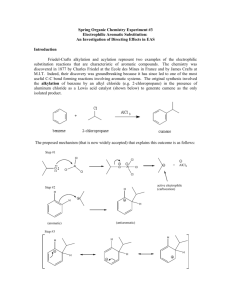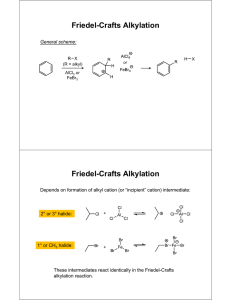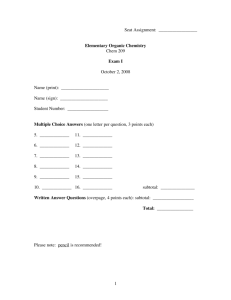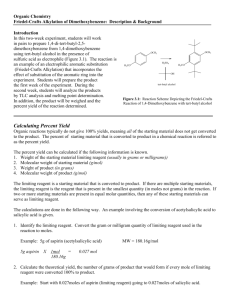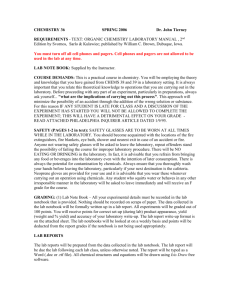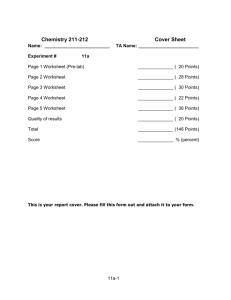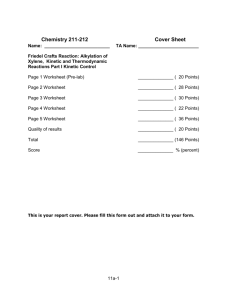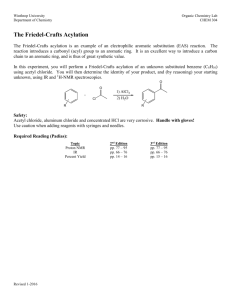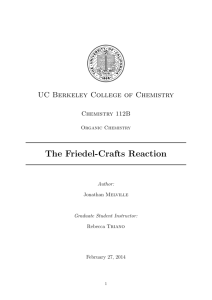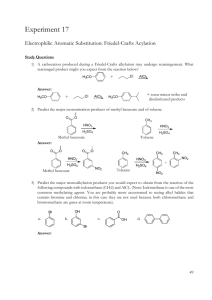handout friedel-crafts reaction
advertisement
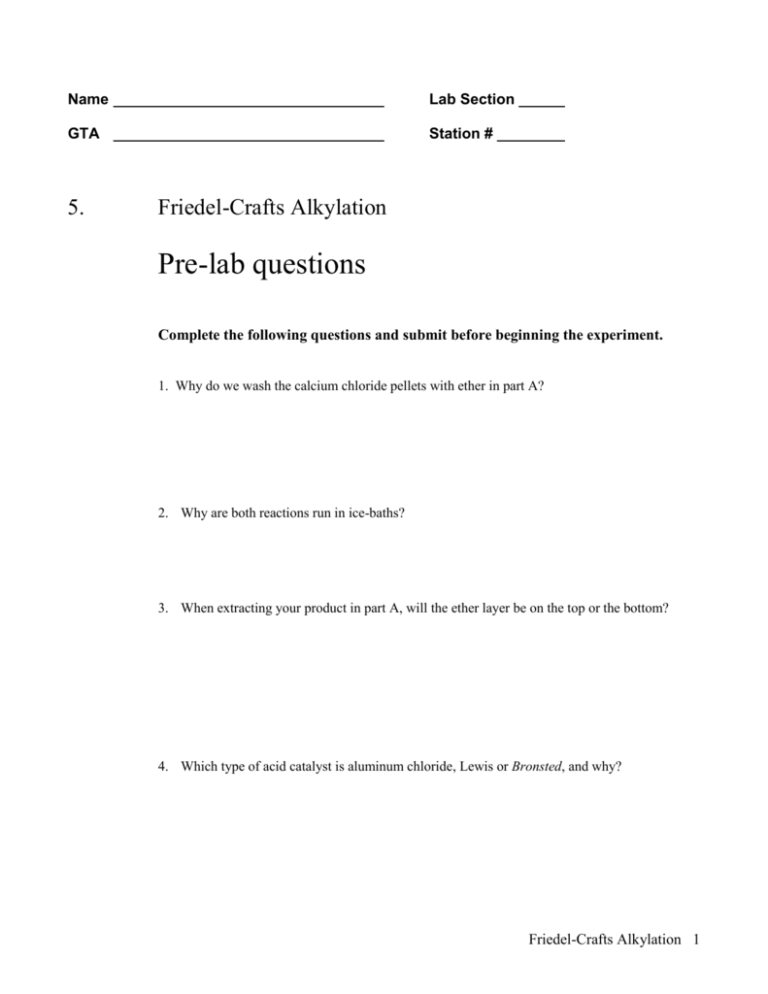
Name Lab Section GTA Station # 5. Friedel-Crafts Alkylation Pre-lab questions Complete the following questions and submit before beginning the experiment. 1. Why do we wash the calcium chloride pellets with ether in part A? 2. Why are both reactions run in ice-baths? 3. When extracting your product in part A, will the ether layer be on the top or the bottom? 4. Which type of acid catalyst is aluminum chloride, Lewis or Bronsted, and why? Friedel-Crafts Alkylation 1 5. Write the balanced equation for both reactions (empirical formulas, not structures). 6. Show the mechanism for the formation of the electrophile in part B. Pre-lab Notebook preparation Prepare the following in your lab notebook before beginning the experiment. 1. Start a “Table of Contents” page near the beginning of your notebook. 2. Start a new page by entering the title of this experiment. 3. Start a section with the subtitle “Procedure - Part A” and provide an outline of the experimental procedure to be carried out. 4. On a new page, start a section with the subtitle “Procedure - Part B” and provide an outline of the procedure. 5. On a new page, start a section with the subtitle “Data” and allow at least two or three pages for data entry. Friedel-Crafts Alkylation 2 5. Friedel-Crafts Alkylation Summary: Friedel-Crafts alkylation of dimethoxybenzene. Jones: Section 13.6, pgs. 589-593 McMurry: Section 5.6, pgs. 154-156. Zubrick: Review melting point, pgs. 86-102 Review crystallization, pgs. 104-125 These procedures have been adapted from the microscale procedure described in Macroscale and Microscale Organic Chemistry Experiments by Kenneth L. Williamson. Background The purpose of this experiment is to perform a Friedel-Crafts Alkylation using two different methods. This involves the substitution of an aromatic ring with an alkyl group using a strong Lewis acid catalyst. This reaction belongs in the reaction category of electrophilic aromatic substitution. The dimethoxybenzene contains two activating methoxy groups to allow substitutions but not rearrangements to occur in the product. Normal substitution of an aromatic ring does not occur because of the stability of the ring. It does not act like a normal alkene. In fact, addition of HBr will not occur like it would in the case of an alkene or a diene. A catalyst is required to "convince" the arene ring to undergo substitution and lose its aromaticity for a short time. There are basically three different steps in this reaction: formation of the electrophile, followed by nucleophilic attack of the arene, and rearomatization of the ring. The overall reaction with a mechanism is listed below: Friedel-Crafts Alkylation 3 Cl AlCl3 + Step 1 - generation of the electrophile Cl + AlCl3 Cl Cl AlCl3 Step 2 - nucleophilic attack by arene to the electrophile H H Cl AlCl3 H AlCl3 H H H H Step 3 - regeneration of catalyst and aromatic ring Cl Cl- AlCl3 H + AlCl3 Cl + AlCl3 + HCl H The electrophile wants electrons. It is formed because the chloride has an affinity for the metal (which has an empty p orbital). In the second step, the arene attacks the electrophile forming a resonance-stabilized intermediate. In the final step, there is an equilibrium, which generates the chloride as a base. It pulls off a proton to regenerate the aromatic product. These reactions are known to be extremely exothermic due to the reactivity of the Lewis Acid. You will be performing two different Friedel-Crafts reactions using two different substrates and two different catalysts. The two overall reactions are depicted below: Friedel-Crafts Alkylation 4 The dimethoxybenzene contains two activating methoxy groups to allow substitutions but not rearrangements to occur in the product. Friedel-Crafts Alkylation 5 Experiment There are two parts to this experiment. Part A. Fit a 25 mL filter flask with a hose. To the other end, fit the hose with a Buchner funnel and immerse into a 400 mL beaker of water. Add a full spatula of aluminum chloride to the flask and fit the flask with a rubber septum. With a syringe, add the benzene through the septum, swirl the mixture, and then immerse the flask in an ice-bath. Add t-butylchloride through the septum over a 30-second period with a syringe. When bubbling has ceased and solid has formed, let the reaction stand at room temperature for 5 minutes. Test the pH of the water in the beaker. Add 3 mL of water to the flask through the septum. Pour the contents into a small reaction tube. Quickly remove the funnel from the water trap. Rinse the flask with 2 mL of ether and add to the tube. Extract the ether layer and place into another reaction tube. Rinse the flask twice more with ether (2 x 2 mL), adding each wash to the reaction tube, extracting the ether layer, and combing with the previously extracted ether layer. Dry the organic layer with calcium chloride. Gravity filter the solution into a 50 mL Erlenmeyer flask and wash the pellets with ether. Combine the wash with the rest of the ether layer. Evaporate off the ether on a hot plate in the hood. Place the flask in an ice-bath to form a solid. Recrystallize the solid in methanol. Part B. In a large reaction tube, dissolve 500 mg of p-dimethoxybenzene in 2 mL of glacial acetic acid. Add t-butyl alcohol and place the tube in an ice-bath. You may have to heat the vial of t-butyl alcohol in a hot water bath to aid in this transfer. In small aliquots, add 1.6 mL of concentrated sulfuric acid with stirring after each addition. After addition is complete, let the reaction stand at room temperature for 15 minutes. Place the tube back into the ice bath and add 10 mL of water in small aliquots. When addition is complete, add an additional 10 mL of water. Vacuum filter and recrystallize solid in methanol. Friedel-Crafts Alkylation 6 Name Lab Section GTA Station # 5. Friedel-Crafts Alkylation Post-lab report Fill out the appropriate sections below. Part A Volume of benzene added Volume of t-butyl chloride added Moles of benzene used Moles of t-butyl chloride used Mass of product Moles of product Theoretical yield Percent yield Melting point Show calculations. Friedel-Crafts Alkylation 7 Part B Mass of p-dimethoxybenzene Volume of t-butyl alcohol Moles of p-dimethoxybenzene Moles of t-butyl alcohol Mass of product Moles of product Theoretical yield Percent yield Melting point Show calculations. 1. What is the purpose of the water trap used in part A of the experiment? 2. For the following reaction, explain why the products were obtained in the indicated amounts. + Cl AlCl3 + 40% 60% Friedel-Crafts Alkylation 8 3. Concentrated sulfuric acid burns paper, so why were you able to use filter paper to collect your product in part B? 4. If the following molecules were used instead of dimethoxybenzene indicate where a t-butyl group is most likely to go (there may be more than one place). NH2 NO2 CH3 Friedel-Crafts Alkylation 9

